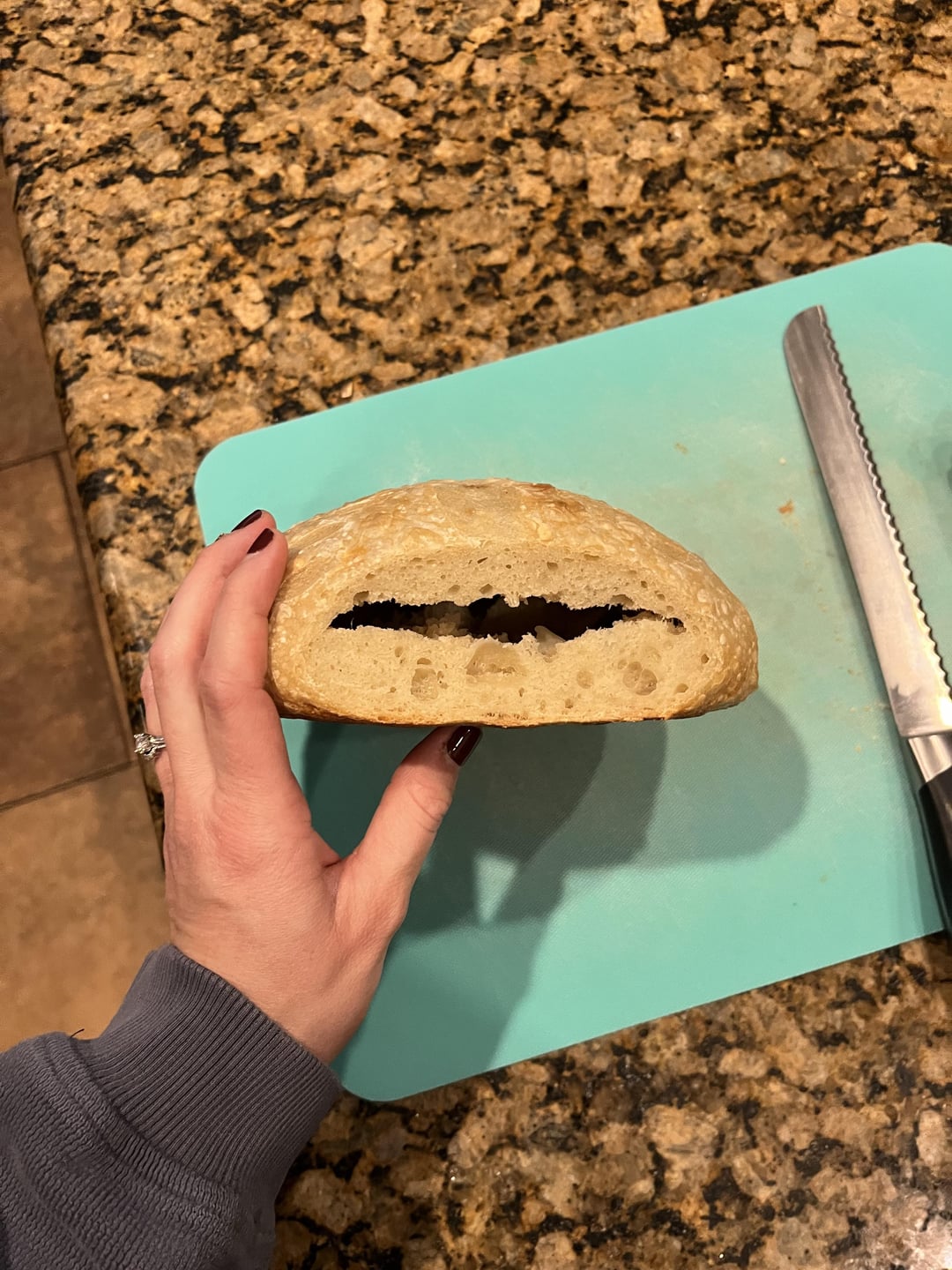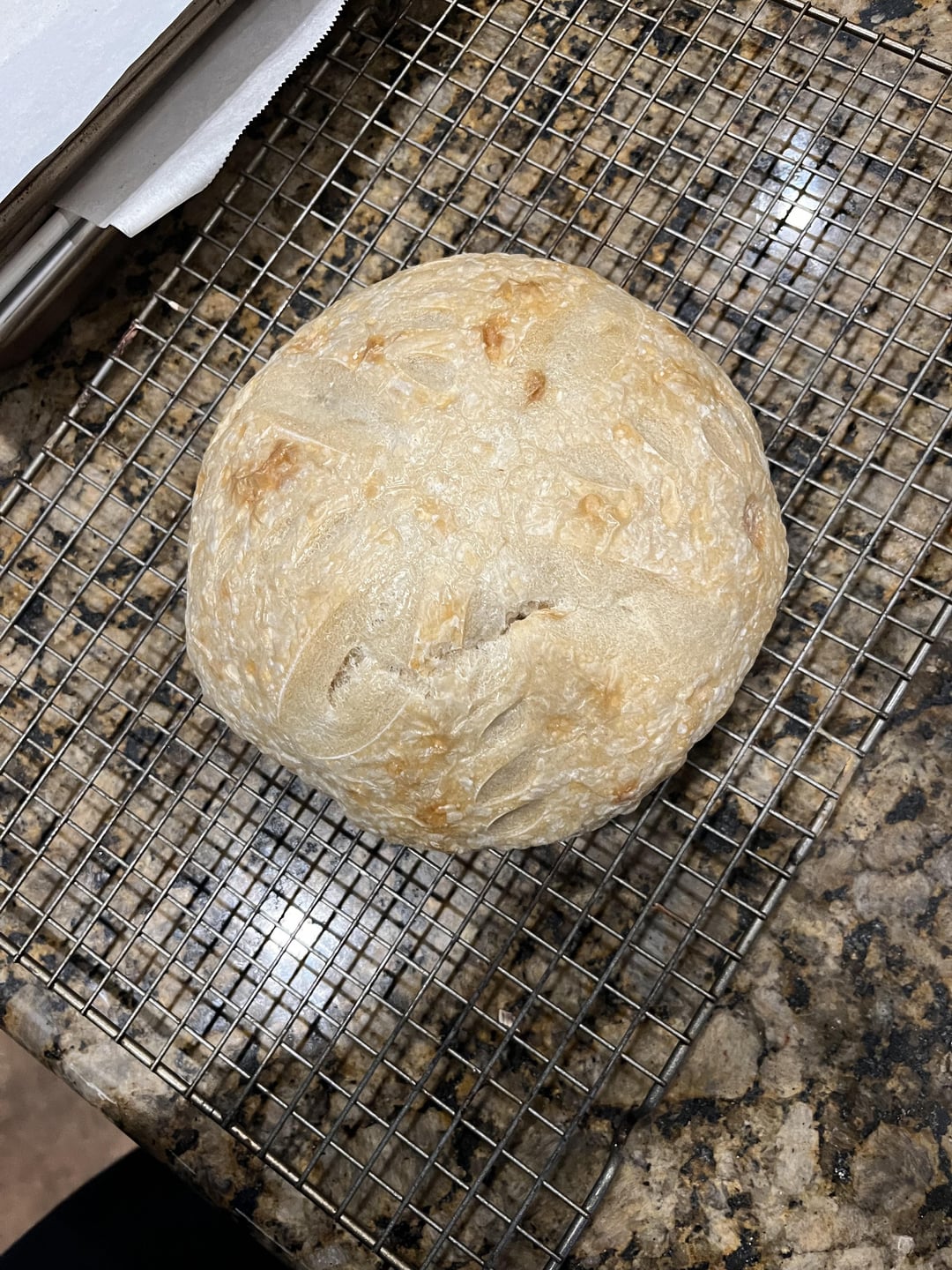

I have an idea on some of the things I could have done differently. I.e.- shaping changes, flour in the banneton(straight up forgot, two toddlers wobbling around the house aids in the exhausted brain). I’ve gotta say it’s honestly depressing when you spend so much time on a loaf hoping you’re going to get a beautiful product to cut into this practically explicit looking bread 😩. Any tips on how to get your starter to double in cold climates? Thanks in advance friends…
by mamatothreee


25 Comments
When it’s cold I feed my starter with warm.water, and try to keep.that warmth with some clothes around the flask where I keep it.
Still, I would try to proof the dough for longer, almost double the usual.
hi! so as you suspected your loaf is pretty underproofed. i struggled with this a LOT. here is how i got mine to proof adequately (sometimes they’re still underproofed a little bit but they’re always edible and super tasty the crumb just isn’t where i would want it)
make your dough and do only two sets of folds
leave it to bulk ferment on the counter for 14 hours (if your kitchen stays at around 67 degrees)
then shape your loaves and cold proof for 8-12 hours in the fridge
then bake! i hope this helps, im also going to post the bulk ferment temp guide i follow.
Hey everybody starts somewhere. This sub often encourages unrealistic expectations. I think it’s good to share the fails, personally.
If you’re trying to encourage fermentation in cold climates, number one piece of advice is get yourself a probe thermometer to track the temperature of your dough. Even before mixing it’s an incredibly useful tool. For example, if your flour is at 60 degrees then you might want to come in with warmer than usual water. Maybe 90-100. This all takes trial and error. Or maybe your house is cold as shit all the time. You may want your dough at 75F but it’s 60 in your house. Aim for an initial DDT of like 85 and your dough will naturally come down. Just a few examples but I think a thermometer takes so much guesswork out especially for beginners.
Ingredients used
-355g room temp tap water (now realizing that could be a problem too)
50g starter
500g unbleached all purpose flour
9g pink Himalayan salt
Heat! Options include a fermentation band, a cooler with hot water in it, starter and dough close to heater, I’ve never tried a heated blanket but that seems possible etc. def makes for something that takes a bit more attention though. Or, just add more time
Hey, don’t worry, most of us had loafs like this in the beginning! The two things that troubled me the most when I started were bulk fermentation and folds. Why, how long, how many folds, what should I be looking for. I had so much difficulty to “read” the dough and understand if I was doing too little or too much lol. I’m still relatively new but at least I can make consistent good loafs now and it makes me so very happy.
For me, the solution was a lot of videos by the Sourdough Journey. Look him up on YouTube. His videos can be long but packed with information to help us *understand*. There’s everything there, from starter maintenance to folds and shaping methods.
And also practice! Don’t ever give up. Only yesterday I decided to do a much bigger batch to gift loafs to some friends and messed it up. I baked them anyway, because it all helped me understand what was different and how to get better. Practice, sourdough friend and all will go well.
I feel better about myself
Seriously though best of luck to you, i hope it works out better next time!
r/dontputyourdickinthat
[Improve your starter ](https://youtu.be/Y0OOvIgCdy4?feature=shared)
Don’t feel too bad
https://preview.redd.it/796ml1d4qyce1.jpeg?width=3072&format=pjpg&auto=webp&s=0465a88ceb9542db4db7d5bad46f7a0baf5ca7dd
Don’t give up.
I had so many failures at first, mostly because my starter wasn’t strong enough.
I found that using warmer water for my starter and proofing either inside my microwave or turning on the microwave light (that shines down on my stove) and placing the dough about a foot underneath helps.
Looks like a pita 😂 shove something delicious in there
Look at all the good points. You got the crumb, you have the shape, you most likely have the amazing taste of fresh bread. It may have been in the shaping, but now I see you mentioned toddlers! I am impressed as heck you’re even making bread! Keep at it!!! It’s hard with little ones around. I remember stirring the pot nursing one baby so could actually eat a hot dinner for once, while my toddler was clinging to my leg. At the time I was stressed but now it’s a pleasant memory.
“Everywhere I look something reminds me of her”
I saw in some other comments you mentioned temp and it being cold. My house tends to sit under 70F in winter and my “hack” to get my dough to ferment is by setting it on the countertop above my dishwasher. The dishwasher cycle warms the countertop, and gives my dough the little extra oomph it needs in cold weather. Keep trying, you got this!
When my starter is cold I’ll wrap it in a towel and place it in front of the floor vent in our kitchen or in a lower cabinet that’s right above a floor vent.
My husband still teases me about my early efforts at sourdough which usually ended up with me throwing the little bread bricks in the trash! Don’t feel bad, it’s a process and the rewards once you succeed are worth it. Also, even a “bad” loaf tastes great dipped in extra virgin olive oil! What recipe did you use and how long did you proof your dough? Making sourdough is my passion and I’d be happy to teach you along the way. Feel free to send me a chat message and I can help.
https://preview.redd.it/scf89xqkxyce1.jpeg?width=4032&format=pjpg&auto=webp&s=ca01ed50c079f936c107e336cf0273155dd0999e
Two things:
You can still use that bread! Croutons, bread pudding, bread soups, and so on. So don’t feel like it’s a total loss.
Also seeing lots of tips here on warming up the process. I keep my place cold (the thermostat is at 60) and I just roll with a long rise. Bulk fermentation 12 hours with a turn every 60-90 minutes (or when I remember), normal bench rest of 20 min, then let the shaped dough hang in the fridge overnight another 10 hrs or so. So far, I’ve been happy with the results.
Hey it’s still bread and I bet it tastes great!
You could make some french toast and your toddlers could have a “pond” of syrup in the middle.
op, these are my first and latest loaves: https://imgur.com/a/vy7kNhq
keep going! read and get yourself informed and you will get to it!
What were that loaves first words?
I live in colder climate (it’s a high of 8F today!) and I feel your pain on the long proofing time. Here are my two tricks for bulk fermentation:
1. Run a towel under very hot water. Wring out the water but still ensuring the towel is damp. Use that to cover your container. Repeat in 6-8 hours depending on how long your BF is.
2. Turn on your oven for a VERY short period (0-60 seconds), turn it off, and bulk ferment in there. Depending on your house temp and what oven you have, you’ll have to play around with how long to leave it on. Basically you’re trying to create a 74-78 F environment for a shorter BF.
That’s where you put the meat and cheese!!
My house is freezing! I got a thermometer and a heat pad and it’s really helped.
You made a thicc sourdough pita pocket, not bad!
One of us! One of us!